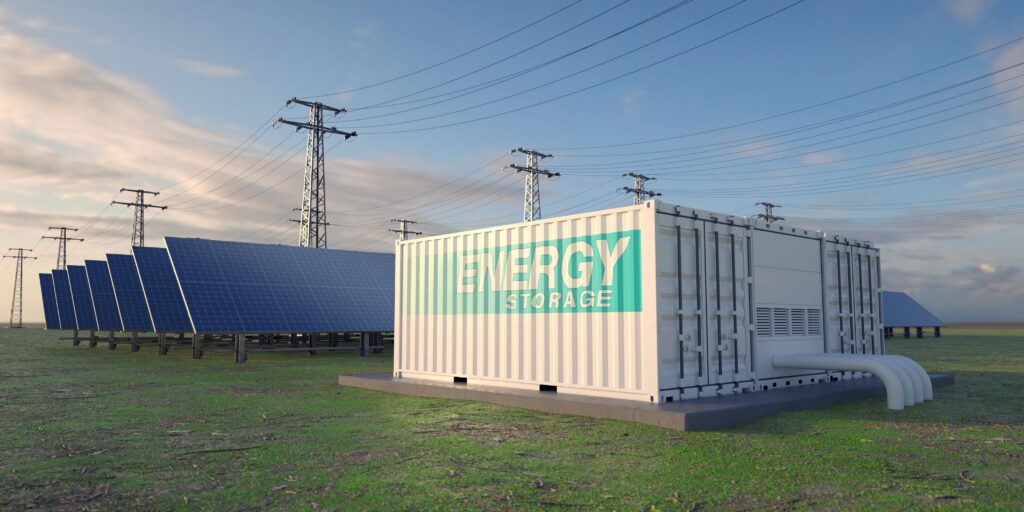Battery Energy Storage Systems (BESS) are transforming energy management by storing electricity from renewable and conventional sources for efficient use when needed. Whether capturing surplus power from wind and solar or providing critical grid support, BESS enhances reliability and sustainability.
Beyond the batteries themselves, these systems include advanced inverters, control mechanisms, and management tools to optimize charging, discharging, and grid integration. With applications including large-scale industrial deployments, BESS plays a vital role in stabilizing energy systems. As technology advances and costs decline, battery storage has become an essential investment for a cleaner, more resilient energy future. In this article we will introduce you to BESS battery storage, BESS technologies and BESS applications.
BESS Meaning: Battery Energy Storage Systems
A Battery Energy Storage System (BESS) gathers energy from both renewable and conventional sources, storing it in rechargeable batteries for efficient use when needed. These batteries can be powered using surplus electricity from sources including wind or solar farms.
When needed—during peak demand, outages, or for grid stabilization—the batteries discharge to supply power. Beyond the batteries themselves, BESS battery storage also includes essential components that enable integration with the electrical network.
When designing a Battery Energy Storage System (BESS), the most important parameters are the power capacity, measured in MW or kW—which determines the rate at which energy can be stored or delivered—and the energy storage capacity, measured in MWh or kWh, which defines how much energy the system can store. For an efficient design, these two parameters must be carefully selected, as the requirements may vary depending on the final application of the BESS. Battery storage systems range in size and include vast utility-scale battery storage power stations that span entire streets or industrial zones.
BESS typically includes the following technologies:
- Inverters: convert direct current (DC) to alternating current (AC).
- Integrated Sensors: track the performance and status of the BESS, gathering essential data to enhance its efficiency.
- Control Components: control the charging and discharging of the batteries while overseeing the flow of electricity to and from the grid.
- Battery Modules: battery modules consist of multiple batteries that function collectively to store and discharge energy.
- Cooling Systems: keep optimal temperature for battery performance and longevity, using air or liquid-based cooling methods.
- Battery Management System (BMS): ensures safe and optimized battery operation by monitoring voltage, temperature, and state of charge.
- Energy Management System (EMS): Oversees battery charging/discharging, optimizing energy distribution based on demand and availability.

What types of battery storage technologies are currently available?
A number of different types of battery storage technologies are currently available.
Lithium-Ion batteries
Lithium-Ion batteries are the most popular choice for utility-scale and commercial storage due to their high efficiency (approx. 95%), long lifespan, and compact energy density. LIBs are widely used for solar and wind energy storage, grid stabilization, and EV charging stations. However, sourcing critical raw materials can bring environmental and ethical challenges.
Sodium-Ion batteries
A promising alternative to LIBs, they offer better sustainability and use fewer critical raw materials. While slightly lower in energy density, SIBs are ideal for stationary applications, such as grid-connected storage. With costs decreasing, they are currently gaining traction in utility-scale projects.
Sodium-Sulfur batteries
NaS batteries are well-suited for large-scale grid storage and recognized for high energy density and long cycle life. They require high operating temperatures, making them less common in smaller applications but effective in industrial-scale energy storage.
Lead-Acid batteries
Reliable and widely used for decades, lead-acid batteries remain popular due to their low cost and the easy availability of raw materials. However, they are significantly heavier and larger than lithium-ion alternatives, have a shorter lifespan (in terms of charge/discharge cycles), and offer lower efficiency (around 80%).
Flow batteries (Redox flow)
Flow batteries offer scalable power and energy capacity using liquid electrolytes stored in external tanks. They provide long-duration energy storage and extensive lifespans, making them ideal for grid balancing and renewable energy smoothing. Though still emerging, vanadium redox batteries show significant commercial potential.
BESS applications: how do these improve energy management?
BESS applications are the different ways Battery Energy Storage Systems are used to improve energy management. They help store electricity so it can be used when needed, making power systems more efficient, reliable, and cost-effective.
- Microgrids: Provides backup power and stabilizes independent energy systems, even if the main power grid fails.
- Peak Shaving: Electricity demand spikes at certain times. BESS helps reduce costs by providing stored energy during those peak hours.
- UPS Support: Ensures uninterrupted power to critical equipment (like hospitals, data centers, and factories) during outages.
- Frequency Regulation: Maintains grid stability by quickly responding to fluctuations in power frequency.
Why invest in battery energy storage solutions?
Technology advancements
Advancements in battery efficiency and extended storage capacity make these systems more reliable. Decentralized solutions support a shift away from full grid dependence.
Falling installation costs
Falling installation costs have made these systems more affordable, with additional savings through peak shaving and a decreasing cost per kWh.
Battery Energy Storage Systems play a crucial role in transforming the energy market. They provide essential grid services and deliver energy during peak demand at more competitive rates than conventional generation plants. Additionally, they enhance the flexibility of the electricity system and support distributed generation, a key feature of the evolving energy landscape.
Solutions for energy management and hybrid energy management at GPM
According to the DNV ETO report of 2024, “Flexibility and energy storage play critical roles in a power system undergoing significant transformation. Our projected seven-fold increase in renewable power generation will drive a corresponding 17-fold expansion in global utility-scale energy storage capacity, growing from 1.75 TWh in 2023 to 30 TWh by mid-century.”
At GreenPowerMonitor, a DNV company (GPM), we understand that renewable energy assets demand precision, reliability, and proactive management to operate at peak efficiency. That’s why our onsite solutions bring expert support directly to your energy projects, ensuring ongoing optimization, optimal control, and monitoring.
Battery Management System (BMS) at GPM
At GPM, clients are increasingly focused on extending the life cycle of their batteries, which directly impacts the longevity and success of their energy projects. Why is this important?
- Because batteries are highly sensitive to factors like temperature, voltage, and current, precise monitoring and control are essential to ensuring optimal performance.
- State of charge management is also critical—avoiding overcharging and carefully regulating the depth of discharge can significantly influence battery lifespan.
GPM accounts for this with its own BMS solution which ensures the optimal operation of the plant, setting State of Charge (SoC) limitations and balancing the SoC of the different subsystems of the BESS. Functionalities here include expanding the BESS lifespan.
GPM Energy Management System (EMS)
GPM’s Energy Management System (GPM EMS) controls power absorption and injection, and maintains the operational efficiency of the BESS, ensuring its capacity to provide grid support services.
The EMS plays a crucial role in monitoring system performance, optimizing energy dispatch, and ensuring longevity and maintenance of your BESS. Some of the key features include:
- Optimizing energy storage to enhance efficiency
- Advanced automation for power plant control
- Grid support functions and ancillary services
- Real-time adaptability and flexible integration
- Ensuring grid code compliance
GPM Hybrid Energy Management System (HEMS)
GPM’s Hybrid Energy Management System (HEMS) consists of a number of integrated GPM software services designed to manage the complexity of hybrid power plants.
The HEMS ensures optimal operation, maintains grid code compliance, and efficiently coordinates and controls both PV solar and BESS technologies. The system operates during peak demand periods and grid disturbances, as long as energy is available in the Battery Energy Storage System (BESS). Some of the key features include:
- Performs accurate active and reactive power control
- Ensures optimal operation and seamless grid code compliance
- Maintains flexible operations during peak demands and grid disturbances
- Balances the State of Charge (SoC)
- Automates site control through system integrations
- Creates a production schedule based on generation forecasts
Download our brochure today and discover our range of on-site power plant control services including GPM EMS and GPM HEMS.
Conclusion
Battery Energy Storage Systems (BESS) are transforming the way we manage and utilize energy, providing flexibility, stability, and efficiency in an increasingly renewable-driven market. By enabling the reliable storage and distribution of electricity, BESS supports grid resilience, optimizes energy costs, and accelerates the transition to a cleaner, more sustainable future.
As technological advancements continue and adoption expands, battery storage will play an even greater role in shaping modern energy systems. Investing in these solutions today ensures long-term benefits—enhancing reliability, supporting decarbonization efforts, and bringing new opportunities for innovation in the energy sector.

